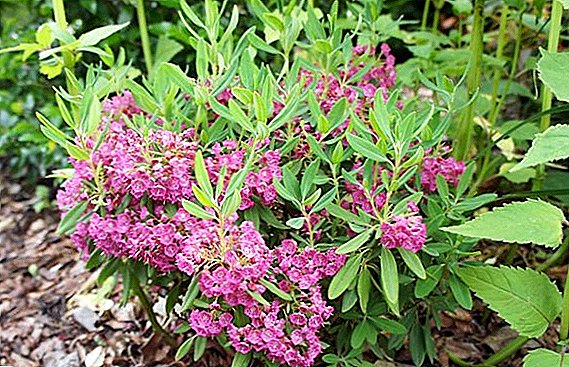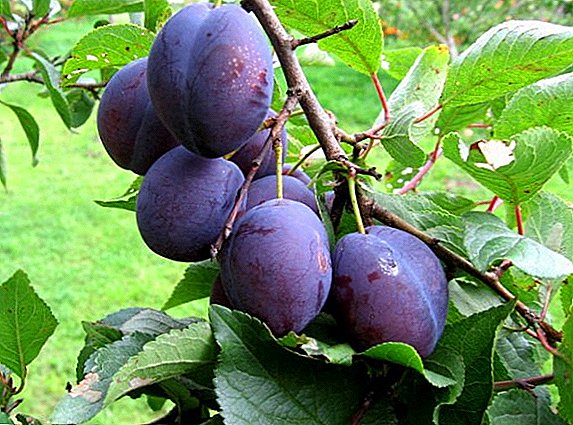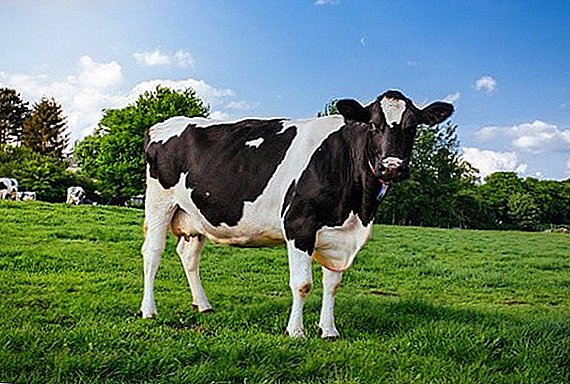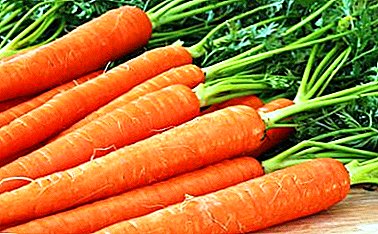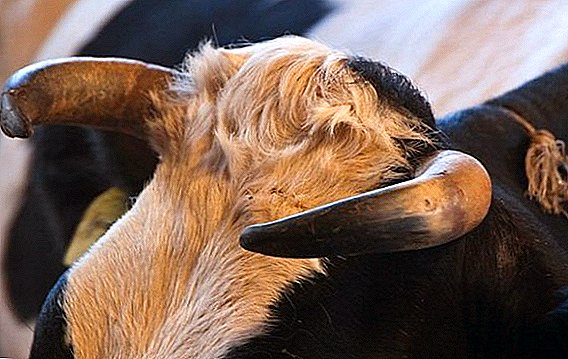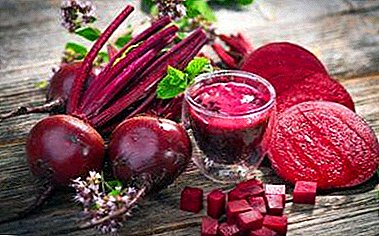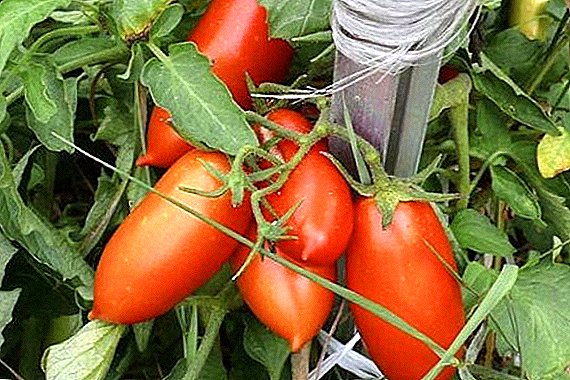 The owner of a large vegetable garden with good soil wants to get not only a rich harvest, but also a quality product. In order to embody this, it is necessary to seriously consider the choice of varieties of vegetables. Do not avoid such a choice and tomatoes. In many ways, the problem lies in the fact that the variety of tomato may not be suitable for further canning or die in open ground. But still there are universal vegetables - so is the variety of tomatoes "Ladies' man", which will be discussed further.
The owner of a large vegetable garden with good soil wants to get not only a rich harvest, but also a quality product. In order to embody this, it is necessary to seriously consider the choice of varieties of vegetables. Do not avoid such a choice and tomatoes. In many ways, the problem lies in the fact that the variety of tomato may not be suitable for further canning or die in open ground. But still there are universal vegetables - so is the variety of tomatoes "Ladies' man", which will be discussed further.
Variety description
According to GOST, the variety is mid-season, indeterminate. Bush in height from 1.5 meters. The leaves are large and dark green. Among the advantages of the variety is the transportability, uniform ripening of all fruits, harmonious taste. "Ladies man" long after harvesting, does not deteriorate. Tomato is suitable for preservation. Those who grew the variety, the main advantage is considered yield. 
Learn more about the differences between the indeterminate and determinant varieties of tomatoes.
The variety has few disadvantages. For example, it is contraindicated to plant for beginners in the garden business: planting it requires deep knowledge of agricultural practices and experience. After all, with the wrong location of the bushes in the open field or with errors during the care of the seedlings, you can lose half the crop.
A distinctive feature is the shape of the fruit and good transportability. The variety “Ladies' Man” is considered by many to be early, but its ripeness depends on the region where your plot is located. In the southern lands, tomato ripens faster due to high humidity and plenty of sun.
Fruit characteristics and yield
Tomatoes variety "Ladies man" cylindrical shape. The color of the ripe fruit is rich red, the skin is dense, the fruits are smooth and juicy. The mass of tomato, in accordance with GOST, can vary from 45 to 60 grams, during the whole-canning they do not crack. Tomato, as stated above, is famous for its yield. According to GOST, 10 kg is the standard crop weight per square meter. The high rate is achieved with the help of proper agricultural technology: seed preparation, plant care. 
You will probably be interested to know which varieties of tomatoes are the most productive.
Selection of seedlings
If you do not have the opportunity to plant seedlings, then you can choose it in the market or in the store. The choice must be careful and careful: sellers can fool even with a variety of tomato.
We offer rules that make it easy to choose seedlings:
- The plant should be from 45 to 60 days. Please note that for one bed you need to choose seedlings of the same age - this will simplify the care of a tomato.
- Plant height - up to 30 centimeters.
- The number of leaves on 1 stalk - 11-12. This characteristic applies only to tall tomatoes, such as the Ladies Man. For short, the same number of leaves on the stem - from 6 to 8 pieces.
- Pay attention to the color of the leaves. They must be saturated green.
- The stem of a plant is equal to the thickness of an ordinary pencil.
- Seedlings should be in boxes. If it is in packages, then you can not buy it.
Important! If the leaves of the plant are saturated green, then this is a good sign. But if at the same time they are curled down, it means that a lot of nitrogen fertilizers have been added to the soil - they accelerate the growth of seedlings.

Soil and fertilizer
Good soil for growing tomatoes is considered to be the one where legumes, cabbage, carrots were previously grown. Also fit the place where they grow onions or cucumbers. The land on which they grew potatoes, peppers, or eggplant will not work: after these vegetables there are few nutrients in the ground. In order to plant tomatoes in such a soil, a period of three years and fertilizer is necessary.
Find out what iodine is good for tomatoes.
Note that tomatoes will grow poorly if:
- there is a lot of organic fertilizer in the soil;
- you will flood the plant with water or, on the contrary, water little;
- landing will be too tight.
We advise you to learn how to determine the acidity of the soil at home.
Slightly acidic soil is allowed. Pay attention: loose and mineral-rich soil is considered good. 
Important! If you plant tomatoes in open ground, then avoid shading. If the soil does not warm up well, the plants will die.
Soil preparation for cultivation occurs at the end of summer or at the beginning of autumn; it should be done only in dry weather. During the procedure, dig up the soil and fertilize it. Spring digging also occurs in dry weather, but several times already. It is advisable to do this when the night frosts have passed. During spring preparation apply mineral fertilizers and humus.
Growing conditions
Variety "Ladies' man" can be grown in the greenhouse and in the open field. In the first case, monitor the humidity and temperature of the soil. You should not plant and simply grow tomatoes in the cold ground. In the greenhouse, the temperature should be maintained at + 20 ° C. In this case, the soil should have a temperature of + 12 ° C.
For planting in the open field, choose sunny places, not forgetting that tomatoes need abundant watering. Variety "Ladies' Man" resistant to the first cold and strong winds, loves a lot of light and moderate humidity.
Before sowing tomato seeds in seedlings, you should be familiar with the features of the preparation of fertile soil.

Growing from seed to seedlings at home
If you did not want to buy ready-made seedlings and decided to grow tomatoes yourself, then you should be prepared for this process.
Preparation of seedlings depends on your region of residence. If this is the southern part, then seedlings are sown at the end of February and until mid-March. In this case, the landing in open ground - from mid-April to the end of May.
In the central region, seedlings are sown from mid-March to April 1. Landing in open ground - from mid-May to early June.
In the northern regions, planting seeds should be in the first part of April. Planting in open ground - from late May to mid-June.  It should be understood that these forecasts are indicative. To more accurately select the date of sowing seedlings for your region, you need to know the dates of the end of spring frosts. It is from them, counting 60-70 days ago, you get the date of sowing seeds for seedlings.
It should be understood that these forecasts are indicative. To more accurately select the date of sowing seedlings for your region, you need to know the dates of the end of spring frosts. It is from them, counting 60-70 days ago, you get the date of sowing seeds for seedlings.
Seed preparation
Before planting in the soil seeds are decontaminated. However, this is not required if you bought the product directly from the manufacturer: the seeds are disinfected at the plant. It’s another matter if you collected the material yourself or bought it on the market, because the seeds can be infected with various pathogens.
Disinfection of seeds is carried out with solutions. So, recipes:
- Make a solution of potassium permanganate. It is necessary to add 1 gram of potassium permanganate to 100 ml of water. Wrap the seeds in cheesecloth and dip into the solution. Hold for at least 15 minutes, but it is not recommended to overdo it, otherwise the germination of the material will be minimal. After the solution, rinse everything with water.
- A solution of soda, which is prepared as follows: in 100 ml of water, add 0.5 grams of soda. Wrap the seeds in cheesecloth and keep in solution for 24 hours.
- "Fitosporin" - dilute one drop of solution in 100 ml of water. Hold for 1-2 hours. If “Fitosporin” is in your powder form, then add half a teaspoon in 100 ml of water. Withstand need 2 hours.
- If you want to improve the immunity of future tomatoes, then prepare a solution based on aloe juice. You can buy it in a pharmacy or make it yourself: you will need 1 part of aloe juice and one part of water. Soak the seeds in the solution must be a day.


Important! Soda solution, in which material can be soaked, increases fruiting.Do not forget about soil disinfection - it is especially important if you brought the soil from your garden or bought it on the market. For the soil to be favorable, it is necessary:
- extract in the oven. Preheat oven to 200 ° and leave the soil in it for 10 minutes;
- disinfection with boiling water. This will require a pot with drainage holes. Pour in the soil and pour boiling water over it, let it dry;
- solution of potassium permanganate is relevant not only for the seeds, but also for the soil. Add 1 gram of potassium permanganate to 100 ml of water and spill the soil.
These methods of soil disinfection can be combined or used as independent. But be careful - after such a procedure, the soil must be set aside for 10-12 days in order for it to increase the number of beneficial bacteria.
Content and location
Seedlings better put in the southern part of the room. A window sill will be an excellent option because seedlings will need a lot of light. If it is not possible to grow in a lighted area, then take care of installing fluorescent lamps. The seedlings should be the first 3-4 days as much as possible under the light, preferably the whole day. Only after 4 days the seedlings will need 16 hours of light per day.  High humidity - a prerequisite for growing. Spray young tomatoes need 2 times a day. Watering them is not necessary, spray from the spray. If you do not have the opportunity to do it so often, then use humidifiers. Humidity for seedlings should be at the level of 80-90%.
High humidity - a prerequisite for growing. Spray young tomatoes need 2 times a day. Watering them is not necessary, spray from the spray. If you do not have the opportunity to do it so often, then use humidifiers. Humidity for seedlings should be at the level of 80-90%.
The optimum temperature for seedlings is from + 18 ° to + 25 ° С. At night, the optimum temperature level can be from + 12 ° to + 15 ° С.
Important! The ideal place in the house where you can put seedlings - near the battery. So you will not worry about the fact that tomatoes are frozen.
Seed planting process
Planting seeds produced in the disinfected soil. You can choose any capacity - both cassettes and peat pots. Pour half of the container with primer and moisten it, make grooves in it not more than 1 cm deep.  The distance between each such groove is 1-2 cm. The distance between rows (if you sow in large containers, for example, boxes) is no more than 3-4 cm. Sprinkle with soil and moisten the seedlings again.
The distance between each such groove is 1-2 cm. The distance between rows (if you sow in large containers, for example, boxes) is no more than 3-4 cm. Sprinkle with soil and moisten the seedlings again.  There is an even simpler option: pour the soil into the seedling container and arrange the seeds in rows, cover with soil. Do not forget that the soil during planting should also be wet. After the entire procedure, cover the seedlings with glass or cling film. This is necessary in order to maintain a high humidity and microclimate inside, as well as to let in light.
There is an even simpler option: pour the soil into the seedling container and arrange the seeds in rows, cover with soil. Do not forget that the soil during planting should also be wet. After the entire procedure, cover the seedlings with glass or cling film. This is necessary in order to maintain a high humidity and microclimate inside, as well as to let in light. 
Seedling care
Make sure that the shoots do not sink in water or do not dry out. If you still notice an excess amount of water in the soil, then open the seedlings and wait for it to dry. If there is mold on the surface of the soil, then carefully remove the layer and spill the solution of potassium permanganate or antifungal agent. Do not allow drops and high temperatures where shoots grow.
The film is removed from the seedlings after about two weeks, when 2-3 leaves have already appeared on the stem. Consider that with the growth of seedlings it is necessary to proportionally increase the number of waterings, light and temperature.  Some gardeners prefer to dive seedlings, when there are 2-3 true leaves on the stem. This is a must if seedlings are planted tightly. To do this, each plant needs an individual capacity - 0.5 l cups will fit. Two options are possible:
Some gardeners prefer to dive seedlings, when there are 2-3 true leaves on the stem. This is a must if seedlings are planted tightly. To do this, each plant needs an individual capacity - 0.5 l cups will fit. Two options are possible:
- The plant is transplanted into a container with a prepared primer. Before planting in the soil add mineral fertilizers. Well suited 1 tablespoon "Signor Tomato".
- Two plants are transplanted into one container. Due to this, a powerful root system is formed. When the seedlings reach 10-15 cm in height, they are bound by a nylon thread. After they grow together, gently pinch the upper part of the weaker sprout. This option is especially good for the ladies man variety.
Important! If you decide to dive the seedlings, then each plant is buried in the soil to the cotyledon leaves and keep a clod of soil on the roots.
 Pickling seedlings 10-12 days before planting in open ground, seedlings are hardened. You can reduce the temperature to + 14-16 ° C. It is possible to take out seedlings to the open air 4-5 days before planting in the garden, for no more than 3 hours. On the last day, seedlings are left outside. Hardening must be carried out - it will not allow the tomatoes to die in other conditions.
Pickling seedlings 10-12 days before planting in open ground, seedlings are hardened. You can reduce the temperature to + 14-16 ° C. It is possible to take out seedlings to the open air 4-5 days before planting in the garden, for no more than 3 hours. On the last day, seedlings are left outside. Hardening must be carried out - it will not allow the tomatoes to die in other conditions.
The first feeding of seedlings is carried out in 2-3 weeks after the appearance of the first shoots. In the future, fertilizing is done every week. Organic fertilizers in the form of dung or rotted grass are good for tomatoes, options based on guano, as well as biohumus or humic fertilizers are possible. For seedlings need a dose of two times less than that indicated on the package.
Transplanting seedlings to ground
To plant tomatoes in the garden need, if their growth is not more than 30 cm, and the stem is thick and strong. Pay attention to the leaves: they should be 6-7 pieces. Another sign is floral brushes. The "Ladies Man", like the mid-season variety, should have one brush. The internodes by this time should be short.
Important! The appearance of a floral brush marks an early transplant of tomatoes in the garden.
If the day when you are going to transplant tomatoes, there is a strong wind or a lot of sun, then postpone this process. It is better to plant tomatoes on a windless, cool day when it is cloudy. The distance between plants during planting should be about 30-40 cm. The stem should be 2-3 cm deep into the ground - so the root system will be strengthened with new roots. It is necessary to land in the soil, fertilized with peat. At the end, water the plants with warm water under the stem. 
Agricultural technology of growing tomato seeds in the open ground
If you comply with all the conditions for growing tomatoes in the open field, the chances of getting a good harvest are high.
Outdoor conditions
The landing site, wind, soil, and other conditions are important for growing the Ladies Man.
Place: tomato is a thermophilic vegetable. He needs a place where there is no shade and where the soil warms up quickly. It should be remembered that the Ladies Man, like any tomato, does not like drought, so watering in open ground will need to be done more often than in a greenhouse. On the other hand, in a greenhouse the sun may not be enough for a tomato, and the probability of getting a small crop is high.
For tomatoes, soil is important: chernozem with the addition of peat fertilizers (1: 1) would be the best option.
Did you know? The largest tomato was grown in the United States. Its weight was almost 3 kg.
The process of planting seeds in the ground
To seedlings of seed tomatoes appear faster, you need to soak them in growth stimulants for 8-12 hours before planting. This will allow the first shoots to appear in 3-4 days, and not in a week.  Landing features:
Landing features:
- The distance between the rows is 60-70 cm.
- The distance between the holes is 30-40 cm.
- The depth of the hole is 3-4 cm.
The soil is moistened during sowing. 3-4 seeds are thrown into the hole. After completion, everything is covered with earth. Seeds can not be watered immediately after planting - wait for the first shoots.
Watering
Watering young plants occurs as needed, and in the first two or three weeks it is best to water under the stem so that the root system is better nourished. Make sure that the soil does not dry out, otherwise the tomatoes will wither. But in no case do not water them copiously every day: waterlogging will lead to fungal diseases, despite the fact that the Ladies' Man is resistant to diseases. The rate of irrigation per square meter - 3 liters. It is also recommended to spray the bushes with an EM solution (1: 1000) in the first week. 
To simplify the process of watering plants on the site will help drip tape.
Soil loosening and weeding
The soil in which the tomatoes are planted should always be loose. This procedure is carried out after each watering or once in two weeks. To loosen the aisle, in parallel, conducting weeding. The first month after planting loosening is carried out to a depth of 10-12 cm, then, in order not to damage the roots, to a depth of 5-8 cm.
Masking
Paceniks are formed in the axils of the leaves. They are young stalks and in fact are no different from the main stem. Their only disadvantage is that they grow, and the bush is overloaded with fruits in the future. In order to prevent the reduction of fruits, it is necessary to do a pinching, that is, pruning such stalks. It is recommended after each watering to inspect the tomatoes and prevent the growth of additional stems.
Garter
Garter holding is a prerequisite if you want to have a rich harvest. It helps the tomato, because the vertical stems are easier to spray and they have more access to the sun, and excessive moisture in the soil can not harm the fruits, as, for example, rodents.
Important! Garter begin to carry out after 2-3 weeks from transplanting.
There are many ways to garter, among them distinguish the main ones:
- Stakes. Tall tomatoes, such as Ladies' Man, require high stakes (from 2 to 2.5 meters). At the same time, their material can be any: both metal and wood. The peg should be 10 cm from the stem of the tomato. It is necessary to deepen it by 20–25 cm. After the peg has been set, take a string and wind it first around the peg and only then tie the stem. Take care of the garter so that the stem is not damaged later.
- Cells. They can be made from scrap materials, most conveniently from wood. They turn out in the form of a high stool, but without a seat. Convenient in that you can make them wide enough to tie up 4 bushes at once.
- Caps. Any available materials are also suitable for them. The most convenient way to use wire. You can build them on the principle of the same cells, but in the form of a pyramid. Convenient and interesting in that they can be tied up not only tomatoes.



Top dressing
Top dressing of tomatoes takes place in sunny weather. Especially useful mineral root dressing. If cloudy weather persists for a long time, then foliar dressing is produced. In total, three to four procedures are performed during the growing season.
The first feeding takes place 3 weeks after planting tomatoes. You need either a solution of mullein or bird droppings.
The second feeding is made at the very beginning of flowering. Ammonium nitrate and potassium sulfate are added, variants with ashes or manure are possible.
The third feeding takes place 1-2 weeks after the second. During this period, mineral fertilizers are applied to the soil.
The fourth dressing takes place during the fruiting period and is not mandatory. It is foliar — superphosphate is sprayed onto the plant itself.
VIDEO: TREATMENT OF TOMATOES BEFORE FLOWERING If you see that the leaves are bent in tomatoes, then you need to spray the magnesium salt. The best option would be to add ash to the soil. In this case, sluggish leaves may indicate a lack of copper, which can be easily replenished by spraying with copper sulphate solution. Small leaves and small fruits indicate a lack of nitrogen.
Pests, diseases and prevention
Late blight is considered one of the main diseases of all tomatoes. It develops in conditions of high humidity and temperatures below + 10 ° C. It is characterized by blackening of leaves and fruits. This fungal disease can not be removed, but you can carry out prevention in order to avoid the manifestation of the fungus. The first time you need to process after planting seedlings, then observe how the mushrooms grow in the forest: if they are activated, then the fungal flora in the garden too.
To prevent late blight, you can use:
- "Trichopol" (1 tablet per 1 liter of water, spray every two weeks).
- Ash (one week after disembarkation, sprinkle all the rows between the ashes).
- Milk + iodine (for the solution you will need 10 liters of water, where 1 liter of skim milk and 15 drops of iodine are added, the plants are sprayed; the procedure can be repeated every two weeks).
- Copper sulphate (2 tablespoons of copper sulphate are necessary for 10 liters of water, tomatoes are sprayed with a solution just before flowering).
- Biological products ("Ekosil", "Fitosporin").
Find out which varieties of tomatoes are the most resistant to late blight.
If late blight still began to parasitize on your tomatoes, then the crop should be harvested and burned, and the land should be cultivated, and two years should not be planted on it.  Late blight on the fruits of Medvedki, scoops, mites, whitefly and many others can harm your tomatoes. To avoid cases of their appearance on the site, it is necessary to comply with agrotechnical rules. First, you can not fertilize wet soil with mullein. Secondly, loosening will help avoid laying pest eggs, but it should be regular. Thirdly, plant marigolds around the perimeter of the plot - they will serve as a natural barrier for pests. Calendula can be another such protection - it helps especially in the fight against scoops.
Late blight on the fruits of Medvedki, scoops, mites, whitefly and many others can harm your tomatoes. To avoid cases of their appearance on the site, it is necessary to comply with agrotechnical rules. First, you can not fertilize wet soil with mullein. Secondly, loosening will help avoid laying pest eggs, but it should be regular. Thirdly, plant marigolds around the perimeter of the plot - they will serve as a natural barrier for pests. Calendula can be another such protection - it helps especially in the fight against scoops.
Did you know? Tomatoes are not only the usual red color: there are species with black fruits.
Mosaic is a viral disease that most often manifests itself as yellow spots on the leaves and in the form of red stains on the fruit. Affected plants, as in the case of late blight, can not be cured: they are collected and burned.  Mosaic Vertex rot of tomatoes - a disease caused by a lack of water in the soil, high levels of nitrogen in it, as well as a small amount of calcium. Manifested in the form of black spots on green fruits. To prevent, watch for irrigation and do not get carried away with nitrogen fertilizers. If the fruits are affected, they must be removed from the bush, and the bush itself must be shed at the roots and sprayed with calcium nitrate (1 tablespoon per 10 liters of water).
Mosaic Vertex rot of tomatoes - a disease caused by a lack of water in the soil, high levels of nitrogen in it, as well as a small amount of calcium. Manifested in the form of black spots on green fruits. To prevent, watch for irrigation and do not get carried away with nitrogen fertilizers. If the fruits are affected, they must be removed from the bush, and the bush itself must be shed at the roots and sprayed with calcium nitrate (1 tablespoon per 10 liters of water).
But it is worth recalling that the variety "Ladies man" has a strong immunity to major diseases and pests.
Harvesting and storage
Harvesting will depend on the time of planting seedlings or sowing seeds in the ground. The ripened fruits of the Ladies Man have a rich red color and dense skin.
The variety, as noted above in the article, is distinguished by its storage duration and transportability. It is advisable to store the fruits in a cool place without sun access, covered in boxes. Do not forget to touch them to immediately remove the cracked tomatoes.
Did you know? In 1893, the US Supreme Court recognized the tomato as a vegetable, as it was served for lunch, and not for dessert, although in botany it is attributed to berries.
Possible problems and recommendations
Tall variety "Ladies' Man" responds to the garter, tolerates fertilizer and frost well, has excellent immunity. But even if the variety is perfect, the agrotechnical can fail. There may be a fall of leaves or fruits - this means that at the budding stage you have brought in too much nitrogen. Falling leaves and their withering may indicate a problem with watering, because tomatoes grow poorly with poor moisture.  Recommendations for growing tomato "Ladies Man":
Recommendations for growing tomato "Ladies Man":
- Regulate the growth of bushes. Cut the stalks at the beginning of summer, because tall varieties like to grow up first and only then give fruit.
- Watch for watering. On average, one square meter needs 3-4 buckets a week.
- Remove the leaves located at the bottom of the stem, from the ground. They can help fungal plants to spread.
- If you grow seedlings yourself, then feed it with organic fertilizers at least 1 time in 2 weeks.
Observing all the rules of agricultural technology and using high-quality material, you will achieve a good harvest of tomatoes variety "Ladies' man".


